
Photo is from an exhibit at US Armed Forces Museum, Camp Shelby, MS.
| CusterMen MENU: | Italian Campaign | At The Front | Books | Armies | Maps | 85th Division | GI Biographies | Websites |
This does not cover all of the weapons used by the troops. Instead, this page points out some of the more unusual ones---weapons that are not usually considered but were quite common to the average soldier.
These weapons are very common. But this has proven the hardest page to research because very little is mentioned about these weapons in most history books. So, I want to describe some of these weapons and then include quotes from the soldiers that they effected the most.
Mines - Teller, Shu, "Bouncing Betty". Includes the US Mine Detector.
Smoke - An offensive and a defensive tool used by the Allies.
Anti-Tank Ditches - And general info on the German defense lines.
Artillery - German Nebelwerfer rocket launcher, large cannons.Mules - Old technology necessary for mountain warfare.
Propaganda - Samples of the Weapons of Pyschological warfare [TO BE ADDED]
Barrage Balloons - Used extensively in the amphibious landings in 1943.
Quotes- Related to the use and effectiveness of the above weapons.Unless otherwise noted, the photos are from the US Army Series on the History of WW2 and the Pictorial Record, entitled "The War Against Germany and Italy: Mediterranean and Adjacent Areas". Other photos were taken at museums: US Airborne Museum at St. Mere Eglise and US Armed Forces Museum at Camp Shelby, MS.
Mines
US M1A1 Mine Weight: 10.5 lbs
German Teller Anti-Tank Mine "Teller" translates to "plate"
The T-Mines or Teller mines were a family of anti-tank mines that had a large explosive charge designed to disable an enemy tank. The name came from their flat, plate shape. The first variant was the TMi-29 mine that appeared in the 1930's that were twice as powerful as any mine made up to then. It was 18" in diameter and carried 13.2 lbs of TNT. The TMi-35 was a smaller mine that saw service until 1943. The TMi-35 mine was 13" in diameter and weighed 21 lbs and was detonated by pressure placed on the lid that fired a central igniter. The TMi-43 mine was the last of this series to be introduced in WWII. It was similar to the Tmi-35 but it used Amatol explosives.
R-Mine "Riegel" translates to "bar"
The Germans also used "Bar Mines" or Riegelmines to provide anti-tank barriers. This mine proved to be the most effective anti-tank mine of the war.
S-Mine or "Bouncing Betty"
The first "S" mine was the Schrapnellmine 35 (SMi-35). The SMi 35 was buried with just its igniters protruding above ground or connected to trip wires. When tripped, the SMi 35 ejected a small cylinder that scattered some 350 small steel balls over an area of 164 yards. The Allies dubbed these the "Bouncing Betty." The Stockmine operated on a similar principle to the SMi 35; however, the device was fixed on a wooded stake above ground. These are sometimes referred to as "stake mines". The body of the SMi 35 was comprised of a concrete cylinder that held the charge and the shrapnel. The shrapnel was scattered when the trip wire was moved.
Schu Mine
The Schu Mine was a small wood box that measured wooded six-inch by six-inch that conatained a detonator and a solid charge. Another name or spelling for this mine is "Shoe Mine" or "Shoe Box " mine. The "Shoe Box" was a favorite among the Germans. One of the places the Americans first encountered the Schu mine was during the failed attempt to cross the Rappido River on 21 January 1944.
Glassmine 43
In 1943, the Germans introduced another non-metallic mine, the Glassmine 43. This mine had a body made entirely of glass in order to reduce its delectability. Although, inevitably, part of the firing mechanism had to be metal, the mine was still difficult to detect. It is not known if these were used in Italy. See the color photo, below.
Artillery Shells
The Germans also buried artillery shells that had a long detonator. This allowed the artillery shell to be buried beyond the range of the mine detector. See quote below from Engineer.
See Quotes about the effect of mines, below, by clicking on Quotes.

Photo is from an exhibit at US Armed Forces Museum, Camp Shelby, MS.
| Digging
up
a Bouncing Betty Members of 504th Parachute Infantry Regiment practising their mine-detecting skills. See brief history of 504 PIR, below.  |
 |
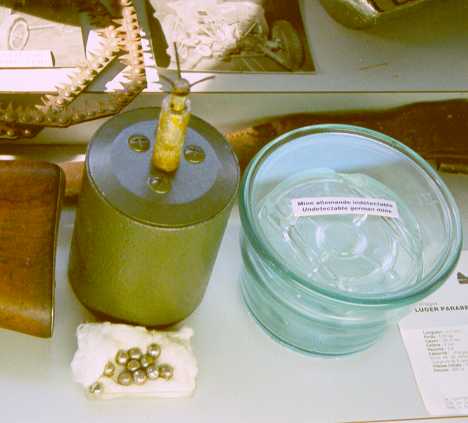
Photo of a "Bouncing
Betty" with examples of the |
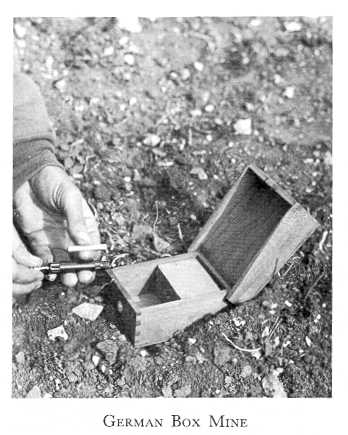
|
Booby-Traps
Any object that would be a soldier would be tempted to pick up and inspect could be rigged
with explosives. The Germans knew that the Americans were curious and always on the search
for food, war souvenirs and any little nick-nack.
Pencil Booby-Trap.
The following description of a booby-trap was reported by 85th Division Intelligence report. In this case, the explosive was found by an inquisitive Italian child.
A booby rap, description as below, caused a civilian casualty in Arezzo on 14 Aug 44, when a chiled of 9 lost three fingers on removing the cap of the tube.
(Sketch drawn full scale measured 5 inches in length and 5/8 inch round)
Description: The trap is made up of light metal, probably aluminum, tube and hexagonal cap with milled edge. The name, directions for use, etc. are in white lettering on a black ground in an elliptical panel surrounded by scroll design in white on a black ground. There is a purple 2/5" wide round the closed end of the tube.
Wording on the panel is as follows:
569
Moorish
Hair Pencil
Scientifically covers white and gray hair
at the roots, temples and har parting.
NON GREASY - HARMLESS
To Apply - moiston tip.
At your local store or post paid $1.00
Mfg'd by E.F. LECHLER
569 West 181st Street New York, N.Y. U.S.A.
--------------------
(I'm not sure how all that info was printed on this small pencil. Maybe it was on the container.)
US Mine Detector
The mine detector used by the US Army was the SCR-625 Mine Detector. It weighed 7.5 lbs and could detect mines buried 6 to 12 inches below the surface. The operator swept it from side to side in front of him and would sweep a path 3 to 4 feet wide. This detector had two faults: it was not waterproof and was very fragile.
The mine detector proved to be inadequate for the Italian Campaign, although it was continued in service. The Italian soil had large amounts of iron ore that made it ineffective. Also, the Germans began to use non-metallic mines such as the Schu mine. In 1944, the SCR-625 was upgraded to the SCR-625(H) Short-Armed Detector Set that weighed only 3.5 lbs. It had a shortened handle to allow it to be used in a prone position.
Once a mine was detected, the operator would point to the location and an assistant would mark the spot. During patrols or assaults on a position, the engineers would sweep a path for the infantry and mark it with white tape(similar to crime scene tape). The bayonet was the most effective tool for probing for non-metallic mines or for removing mines.
SCR-625 Mine Detector
History of 504 PIR in ItalyThe 504th Parachute Infantry Regiment intended to join rest of 82nd Airborne Division in Ireland for training to prepare for the Normandy invasions. Instead they were sent to Anzio upon special request of Prime Minister Churchill.
They formed the 504 Parachute Combat Team that included the 376 Parachute Artillery Btn and 307 Parachute Engr, Company C. They entered the line at Mussolini's Canal and suffered heavy casualties.The US paratroopers got the name "devils in baggy pants" from a German diary found at Anzio.
Above photos are obviously posed photos taken of the 504 PIR in Italy
Smoke Generators - and Smudge Pots
Smoke generators were used extensively in the early days of the Italian Campaign. As the Allies were moving on the offense against a German enemy that occupied the high grounds, concealment was an important factor. Both at Anzio and Cassino fronts, the Allies had to move troops and equipment under the ever-watchful eyes of the German artillery spotter. Smoke was a sure way to blind the enemy and allow movement up close to the front lines as possible.
Photos from the US Army History series.
M1 Smoke Generator This device burned about two 55-gallon drums of oil per hour to produce smoke to cover the Allied positions.
Anti-Tank Ditches & German defense positionsThe German defenses were built by the Todt Organization. TheTodt Organization was an off-shoot of the military labor organization, the Reichsarbeitdienst (RAD), that used labor from civilians drafted into service and civilian engineers. Later, it used forced labor from countries occupied by the Germans and was used in the front line service of the army.
The following describes the preparations in front of the German X Army at the GOTHIC Line located in the Apennine Mountains in 1944.
"All in all, even though limitations of time had prevented full implementation of the Fuhrer's order of early June, the work accomplished by the end of August represented no mean achievement. A report submitted to Kesselring on 3 September revealed the state of completion of the defenses in the Tenth Army's sector on 28 August. Most impressive were the figures for the minor types of installations - 2,375 machine-gun posts, 479 anti-tank gun, mortar and assault-gun positions, 3,604 dug-outs and shelters of various kinds (including 27 caves), 16,006 riflemen's positions (of trees and branches), 72,517 "T" (Teller, anti-tank) mines and 23,172 "S" mines laid, 117,370 meters of wire obstacles, and 8,944 meters of anti-tank ditch. Only four Panther turrets however had been completed (with 18 still under construction and seven more projected), 18 out of an intended 46 smaller tank gun turrets (for 1-cm and 2-cm. guns) were ready, and of 22 Organization Todt steel shelters being constructed, not not one was finished."
From "The Canadians In Italy, 1943-1945" - by Lt.-Col. G.W. Nicholson.
Propagander - To be added later.Return to Main Menu
Artillery
"Anzio Annie" - 280mm railroad gun
Railroad cannon known as "Anzio Annie" by the Americans and "Leopold" by the Germans. (see Fate, below)
Caliber: 280mm (11.02 inches)
Barrel Length: 70.08 ft Overall Length: 135.28 ft
Shell: 563 lb High Explosive Muzzle Veolcity: 3,700 fps
Max Range: 38 miles
"Anzio Annie" is on display at the Aberdeen Proving Grounds Museum, Aberdeen, Maryland.
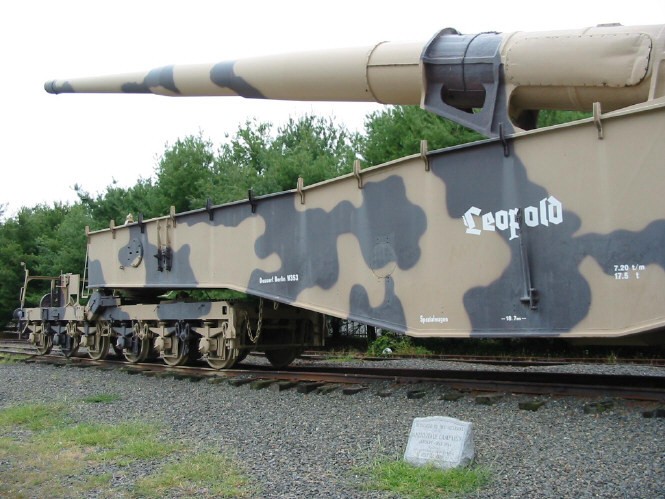
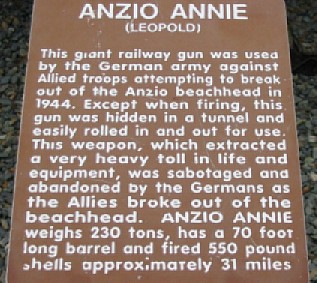
The fate of the Anzio Annie.
The two guns that made up
the German K-5 RR battery in Italy were called "Robert" and
"Leopold".
When the Allies broke out of the Anzio Beachhead, the guns were moved
to
Civitavecchia, located just north of Rome. There "Robert" and "Leopold"
were spiked with explosives and blown in place. On June 7,
1944,
the 168th Infantry Regiment of the 34th Division captured the
guns.
"Leopold" was the less damaged piece and was moved to Naples and
embarked
aboard the liberty ship Robert R. Livingston and shipped to Aberdeen
Proving
Grounds, Maryland. The fate of "Robert" is unknown but supposedly
it was scrapped in Italy after the war. In February of 1946, two
more K-5 RR guns were brought to the US from Germany. Parts off
those
two guns were used to make "Leopold" operational so the gun could be
tested
at Aberdeen.
US 155mm - "Long Tom"
Cadet Officer Bill Dempsey at Fort Sill, OK in 1942, standing next to a 155mm cannon.
This gun does not exactly look like the ones that were used in service. It could be an
early prototype model. Fort Sill was the primary school for artillery officers.
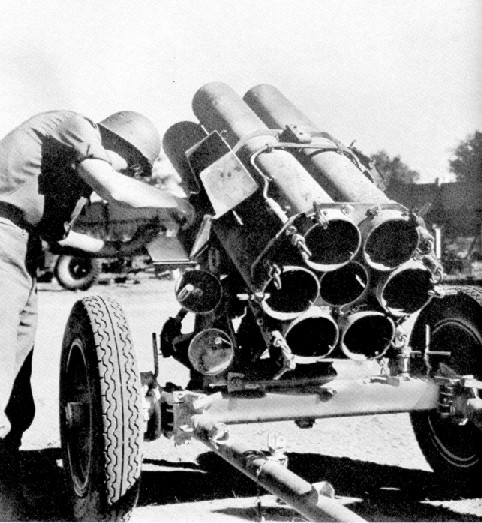
Return to Main
Menu
MulesReturn to Main MenuMules were an essential mode of transportation in Italy due to the mountainous terrain, the lack of adequate roads, and the mud that was everwhere during the fall rainy season. As the war progressed, the Germans depended more and more upon horses and mules for transporting their support units. The Allies used mule trains to move ammo and food up to the troops in the mountains. The ex-military Italians were used to lead these trains as they knew the area and were accustomed to the terrain.
A mule train loaded and ready to traverse the steep trails near Castelforte. This photo
provides a glimpse as to the size of a mule train.
"Muleskinners" loading supplies onto mules for the treacherous trip
up the mountain paths. PHOTO FROM US ARMY HISTORY SERIES"The entire mule train was destroyed. The Italian mule skinners are
hysterical and make no effort to collect any stray animals. They cry
and shout and run off weeping in all directions. To treat them is
impossible. None of them will hold still long enough to be bandaged.
They scramble off the mountain, leaving a trail of blood behind them."
Captain Klaus Huebner, a Medical doctor with the 88th Division,
describes the result of an artillery strike; "Long Walk Through War".
Barrage Balloons
Barrage Balloons were a small balloon that was tethered to the ground or a ship in order to provide an obstacle to discourage low-level attacks by enemy aircraft. These were used extensively in the early years of the war and especially on invasion fleets, as at Normandy and Anzio.
Quoted from "Calculed Risk" by Mark W. Clark, Harper & Brothers Publisher,1950.
Quotes about Mines
Return to Main Menu
"On 5 September, in the vicinity of Signano, Italy, at two fording sites across the Arno, the company removed 97 Tellermines and 12 "S" mines from two large minefields which extended into water 2-1/2 to 3 feet deep and which necessitated probing with bayonets and using mine-detectors in waist-deep water. Some of the Tellermines were booby-trapped with 3 kilograms of explosives to make removal more difficult and dangerous. After the crossing was made, scores of schu-mines and booby-traps were removed on the north slope of the Arno River. " "The road from Massa to Canevara had been made impassable by a 30-yard long crater dug by the retreating Germans on the outskirts of Massa. It was also mined with anti-tank, anti-personnel, and artillery shells converted into mines with pressure devices that were buried too deep for detection by electrical mine detectors or probing. "
"Between 5 April and 23 April{1945}, the Engineers removed over 20 Tellermines, 4 stock mines, 23 R-mines, 57 schu-mines, 47 M2A1 anti-personnel American mines, 5 Italian box mines, 20 12-in artillery shells improvised as anti-tank mines, 1 plastic mine, over 100 pounds of cratering charges; demolished 15 mortar duds and 1 rocket bomb; . . . ."
Quote from T/5 George Goto of the 232nd Engr., 442nd RCT.
A description of the Gothic Line along the German Tenth Army front.
"All in all, even though limitations of time had prevented full implementation of the Fuhrer's order of early June, the work accomplished by the end of August represented no mean achievement. A report submitted to Kesselring on 3 September revealed the state of completion of the defenses in the Tenth Army's sector on 28 August. Most impressive were the figures for the minor types of installations - 2,375 machine-gun posts, 479 anti-tank gun, mortar and assault-gun positions, 3,604 dug-outs and shelters of various kinds (including 27 caves), 16,006 riflemen's positions (of trees and branches), 72,517 "T" (Teller, anti-tank) mines and 23,172 "S" mines laid, 117,370 meters of wire obstacles, and 8,944 meters of anti-tank ditch. Only four Panther turrets however had been completed (with 18 still under construction and seven more projected), 18 out of an intended 46 smaller tank gun turrets (for 1-cm and 2-cm. guns) were ready, and of 22 Organization Todt steel shelters being constructed, not not one was finished."
From "The Canadians In Italy, 1943-1945" - by Lt.-Col. G.W. Nicholson.
"Booby-trapped houses frequently cause casualties. The Germans apparently know that GI Joe is very curious and inspects everything. Forsaken trunks, closets, or attics are their favorites. Never open a previously unopened door or pry open an old trunk, closet, or door."
Quoted from Captain Klaus Huebner in "A Long Walk Through War"
A description of the anti-tank ditch at the Casear Line from History of 91st 'Powder River' Division.
This was the Gothic Line. It was built by the Organisation Todt over 12 months. It included pillboxes, concrete emplacements, som so thick that a 105mm shell bounced off them, barbed wire, tank guns mounted in concrete turrents, minefields, elaborate antitank ditches, and precipitous mountain terrain.Descent of the precipitous northern slope of Mt. Calvi, breaching the barbed-wire entanglements and numerous minefields ahead and getting through an area completely zeroed in by enemy mortar, artillery, machine-gun and snipe fire called for the combined qualities of a mountain goat and Superman.
Monticelli is a rocky, cone-shaped peak, 3,000 feet high, wooded 3/4 of the way up, but devoid of any cover or concealment in the last 600 feet before the summit. On its sides pillboxes and dugouts were built in such a way as to afford protection for each other. They were camouflaged so carefully that they were invisible to the naked eye. One typical pillbox, large enough to accommodate five men, was constructed of concrete with a roof covered with 3 feet of logs and dirt. In front was a firing slit 6 inches high and 3 feet long. Row after row of barbed wire, one foot high and 25 feet wide were placed at 100-yard intervals to the top of the mountain. In two ravines which led to the top of the mountain, the enemy had laid small minefields. On the reverse slope of the peak elaborate dugouts were constructed. They were dug straight back into the mountain to a distance of 75 feet and were large enough to hold up to 20 men. On a hill 300 yards north of Monticelli was found a huge dugout blasted out of solid rock. Shaped like a U and equipped with cooking and sleeping quarters, it was large enough to accommodate 50 men.
Quote from Captain Klaus Huebner, medical officer with 351st Regiment, 88 Division:
"Bracing my hands to get up, I almost set off a mine buried directly in front of me. In my stupidity and gripped with panic, I have jumped into a mine field! I must get back on the highway. I muster all the strength I have left and, sidestepping dangerously exposed mines like a football player does would-be tacklers, leap back onto the road. … The irony of it all is that while I was gone, my guide arrived. The poor fellow is shell-shocked, shakes all over, sobs, and is in a severe state of anxiety. To get back to us he had dodged mortars and air bursts and had stepped on a dud mine--its cap fluttering two feet into the air but the mine not going off. He is incoherent at the moment.""Frequently the narrow road crosses and re-crosses the creek over small wooden bridges. These are usually demolished and we cross on the debris strewn around them. I witness the entire battalion crosss over one such obstacle, except for the last man, who is unfortunate enough to have his foot blown off by a shoe{Schu} mine. How 450 men have crossed over the same path and avoided stepping on that mine is almost unbelievable!"
"Another axiom in seizing an objective seems to be this: never take the easiest and hence obvious route such as a main highway or a secondary road. The Germans expect you to come this way, and therefore such routes are heavily mined and defended. The route to take instead is the most illogical one to the enemy and the most difficult one for us. This means mountain climbing, and that is after all what we practiced for months."
"The next hazard is the crossing of the 2-mile-wide meadow at the foot of Mount La Fine. I am positive that the meadow is heavily mined and zeroed in. At 10-yard intervals the men of my battalion leave the oak forest and commence their treacherous walk across the flat, open plain. I feel as though I am embarking on my death march as I follow the troops across the meadow. Will I survive the assault on La Fine? I am scared to death yet can't afford to show it. The chaplain and I walk together. It is definitely comforting to have him at my side. I know he is a better Christian than I am. God will surely spare him, and if He does I, walking with him, will probably be spared also. I have suddenly become a superstitious foxhole Christian."
Quote from Captain Klaus Huebner, medical officer with 351st Regiment,
88th Division in his book "Long Walk Through War".
Mines were hazardous to both privates and generals.
"Maj.-General H. K. Kippenberger, a New Zealander, stepped on a mine near Cassino which blew off one leg. Looking around, he realized that he was in the middle of a mine field. Nevertheless, he stood up on one leg and began hopping out. He hopped on another mine and went down in a blast of explosives that was only slightly less noisy than the voice in which he roared, "Dammit! There goes the other leg." (General Kippenberger had to walk on two artificial legs.)
Quote from General Mark Clark's book "Calculated Risk", page 264.
Return to The
Italian Campaign Top Menu.